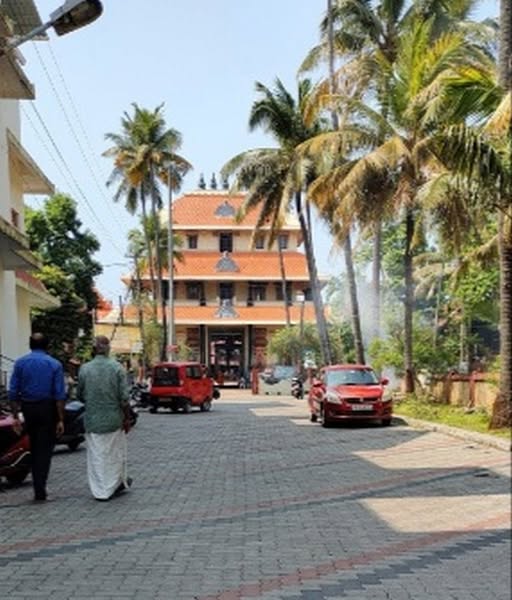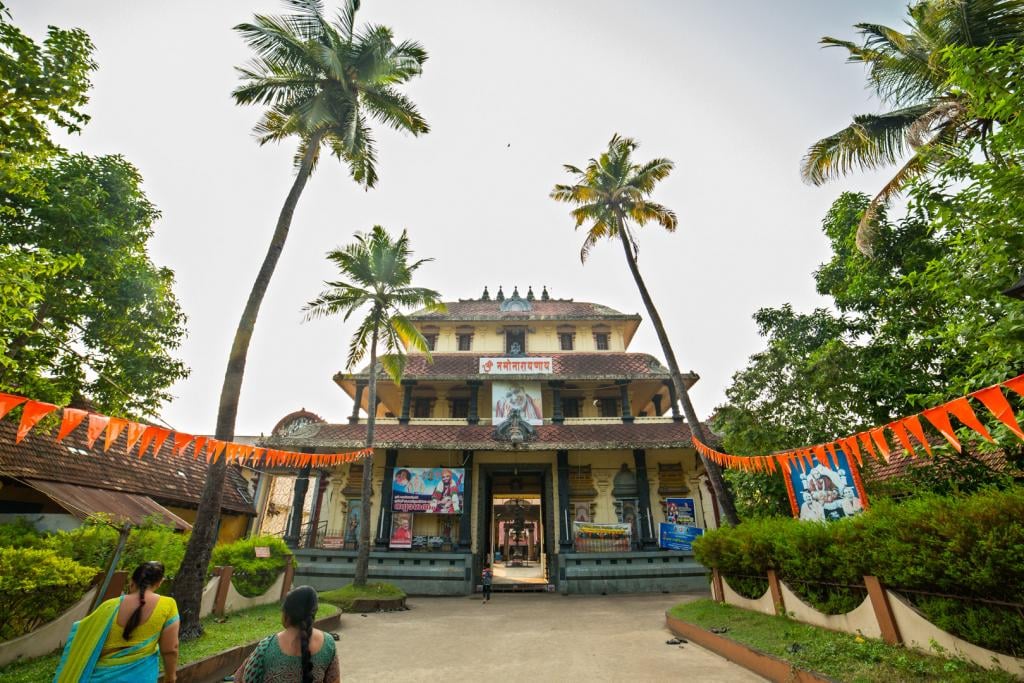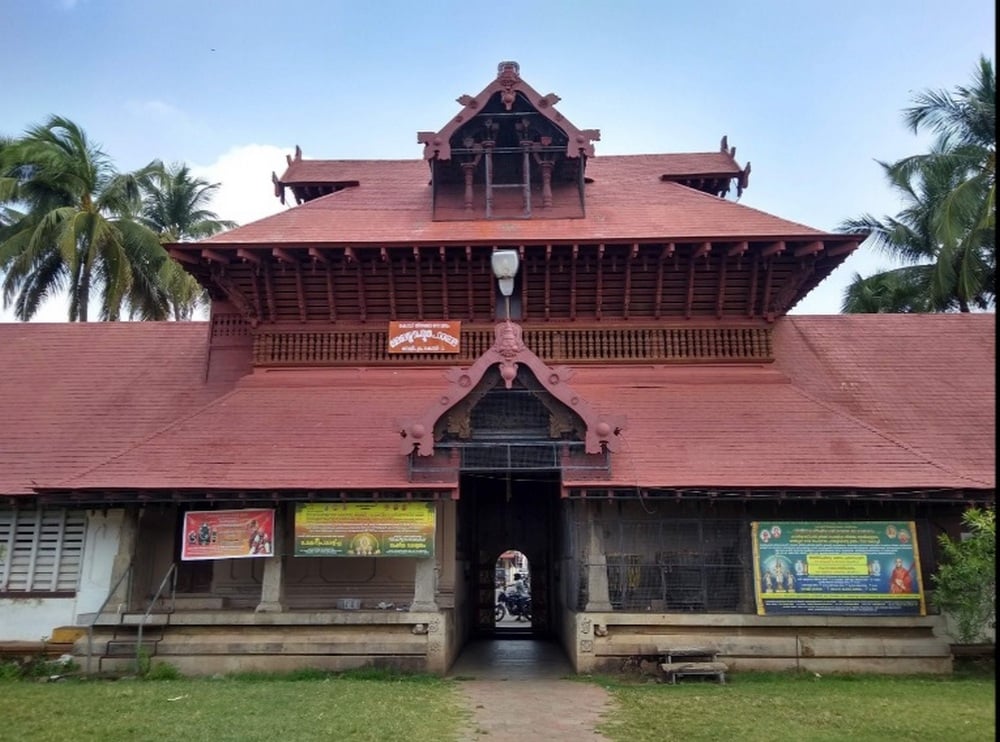Cochin Thirumala Devaswom Sri Venkateswara Temple is the largest and most significant socio-religious center for the Gowda Saraswat Brahmin community in Kerala.

The main idol of Lord Venkateswara is enshrined on the Simhasan (throne), with his divine consorts, Sreedevi and Bhoodevi, on either side. Below, on the middle step, the Utsav Murti (processional deity) along with his consorts is placed, followed by Utsav Lakshmi on the lower step, and the sacred Saligrama at the base.
Within the temple premises, there are four sub-temples dedicated to Goddess Mahalakshmi, Lord Hanuman, Garuda, and Lord Vigneshwara.
Additionally, the Vrindavan (samadhi) of Shri Sukrathindra Thirtha Swamiji, the 19th Madathipathi of Kashi Math, who attained samadhi in 1949, is also located here. A pedestal dedicated to Naga Yakshi is situated in the southwest corner, next to the Vigneshwara Temple.
Outside the temple premises, there are statues of the Vijayanagara king Saluva Narasimha Deva Raya and Swami Vijayendra Theertha of Kumbakonam Math, along with a temple tank. A remarkable feature of the temple is its massive bronze bell, measuring approximately four feet in diameter and six feet in height.
In earlier centuries, the resonating chime of this bell could be heard from great distances beyond the temple grounds. The presiding deity of the temple is Lord Venkatachalapathy. In 1568, following the fall of the Vijayanagara Empire and the forced conversions to Christianity by the Portuguese in Goa, the Gowda Saraswatha Brahmins (GSB) migrated to Kochi. During this migration, Swami Vijayendra Teertha of Kumbhakona Math brought the idol of Venkatachalapathy to Kochi. Even today, a majority of the households around the temple belong to the GSB community.
In 1599, a temple was built to enshrine the idol, but it faced multiple plunderings over time. The Portuguese destroyed the temple in 1662, but it was reconstructed in 1663 during the Dutch reign. In 1719, the idol mysteriously disappeared but was later found on a beach. It was temporarily kept at the Dutch Governor’s residence before being restored to the temple.
The temple faced another attack in 1791, leading to the idol being relocated to Alappuzha for safekeeping. It remained there for several years before being brought back to the temple in 1853.
Gowda Saraswatha Brahmins, also known locally as Konkanis, have been an integral part of the Kochi community since their ancestors settled here in 1560 A.D., escaping the mass conversion policies imposed by the Portuguese in Goa. According to legend, the idol (Vighraha) of Lord Venkateshwara installed in the Cochin Temple originally belonged to the Vijayanagara ruler Saluva Narasimha Deva Raya, who ascended the throne in 1472 A.D. A great devotee of Lord Venkateshwara of Tirumala, the king frequently visited Tirupati for worship.
However, as he grew older and was physically unable to undertake the pilgrimage, he longed to see the Lord daily.
One night, the king had a divine vision in which Lord Venkateshwara appeared and assured him that he need not make the arduous journey to Tirumala anymore. The Lord promised to come to the king’s capital himself. The vision also foretold that a sculptor would soon visit the king, requesting materials to cast an image, and that the image created would be identical to the deity of Tirumala.
As predicted, a sculptor arrived at the king’s court and, after gathering the necessary materials, locked himself inside a room to create the idol. When he did not emerge for a long time, the anxious king ordered the room to be opened. To his astonishment, he found a radiant and magnificent idol of Lord Venkateshwara, identical to the deity at Tirumala. Realizing that the sculptor was none other than Lord Viswakarma, the divine architect himself, the king was overjoyed. The idol, believed to be "Swayambhoo" (self-manifested), became an object of deep reverence and was later installed in the Cochin Temple.
Following the divine vision, the king constructed a grand temple for the installation of the idol. However, before the Prathishta (consecration), Lord Venkateshwara appeared in the king’s dream once again and instructed him that the installation should take place only upon hearing a divine signal—the beating of the Dundubhi (a sacred drum).
As fate would have it, at the expected time of the signal, a few crows flew over the Dundubhi carrying twigs. Some twigs accidentally fell on the drum, producing a sound that was mistaken for the divine signal. The temple priests and the king, believing it to be the Lord’s command, proceeded with the installation.
However, soon after the consecration, the actual Dundubhi sound resonated across the temple, revealing that the idol had been installed at an inauspicious time.
Heartbroken by the mistake, the king retired to his chamber in despair. That night, Lord Venkateshwara once again appeared in his dream to console him. The Lord assured the king that he would remain with him until his final days but also revealed that due to the inauspicious timing of the installation, he would eventually leave the city and reside in Gosripuram—later known as Kochi (Cochin).
On March 2, 1662, the Portuguese destroyed the temple, plundering the homes of the Konkani community and looting the markets. Fearing for the safety of the Vighraha (idol) of Lord Venkateshwara, the community fled to Udayamperoor, near Tripunithura, seeking refuge. For nearly ten months, they lived there as displaced people, enduring hardships without proper shelter. During this period, they took a solemn pledge to establish their settlements across sixteen different locations—eight in the Cochin Kingdom and eight in the Travancore Kingdom. Each of these settlements was to have a Tirumala Devaswom temple and would be referred to as a "Gramam." This pledge led to the establishment of the sixteen Tirumala Devaswoms that exist today.
On January 6, 1663, the Dutch defeated the Portuguese in a decisive battle and took control of Fort Cochin. With their support, the Konkani community returned to Cochin, bringing the sacred idol with them. They re-established their settlement and, with the assistance of the Dutch, constructed a new temple for Lord Venkateshwara. In the year 1719 A.D., the Second Prathishta (reinstallation) of the idol was performed by H.H. Swami Devendra Thirtha of Sri Kashi Math, along with his disciple, H.H. Swami Madhavendra Thirtha. The year 1791 witnessed a brutal persecution of the Konkani community under Raja Rama Varma IX, famously known as Sakthan Thampuran.
On October 12, 1791, a large number of Konkani merchants, including Dewaresa Kini, were massacred on his orders. The Raja also ordered the execution of three guardians of the Thirumala Devaswom Temple, as they refused to surrender any part of the temple's treasures. Following this, he plundered the shops around the temple, seizing the property of Konkani merchants before looting the temple itself. The value of the wealth taken from the temple alone was estimated at over 1.6 lakh.
Fearing further persecution, the Konkani community fled southward to Thuravoor and Alappuzha (Alleppey) in the Kingdom of Travancore, carrying with them the sacred murti of Sri Venkateshwara.
In Alappuzha, they found refuge under the protection of Dharma Raja, the ruler of Travancore, and built a new temple on the banks of the Alappuzha canal. Sakthan Thampuran and his successors made several unsuccessful attempts to bring the deity back to Cochin, but the Maharajas of Travancore, who believed that the presence of the murti and the Konkani merchants brought prosperity to their kingdom, firmly resisted these efforts.
Finally, in 1853, during the reign of Kerala Varma IV in Cochin, the Konkani community agreed to return. On February 7, 1853, the sacred murti of Sri Venkateshwara was brought back to Cochin. The third Pratishtha (reinstallation) of the idol in the resanctified temple was performed in 1881 by Swami Bhuvanendra Thirtha, along with his disciple and designated successor, Swami Varadendra Thirtha.
തിരുമല ദേവസ്വം ശ്രീ വെങ്കിടേശ്വര ദേവസ്ഥാനം
കേരളത്തിലെ ഗൗഡ സരസ്വത് ബ്രാഹ്മണരുടെ ഏറ്റവും വലിയതും പ്രധാനപ്പെട്ടതുമായ സാമൂഹിക-മത സ്ഥാപനമാണ് കൊച്ചി തിരുമല ദേവസ്വം. കേരളത്തിലെ പ്രശസ്തമായ മഹാക്ഷേത്രങ്ങളിൽ ഒന്നായി ഇതിനെ കണക്കാക്കുന്നു. ദൈനംദിന, പ്രതിവാര, പ്രതിമാസ, വാർഷികമായി ക്ഷേത്രത്തിൽ നടക്കുന്ന വിവിധ ചടങ്ങുകളും കമ്മ്യൂണിറ്റി അംഗങ്ങൾ നടത്തിക്കുന്ന പ്രത്യേക സേവനങ്ങളും ഈ ക്ഷേത്രത്തെ മഹത്വമുള്ള പുണ്യസ്ഥലമാക്കി മാറ്റുന്നു.
വാസ്തുവിദ്യയുടെ ആഢംബരവും ശൈലിയും കണക്കിലെടുക്കുമ്പോൾ ഗോശ്രീപുരം ക്ഷേത്രം അത്യന്തം മനോഹരമായൊരു പ്രതീകമാണ്.
ഇന്ത്യയിലെ പല ക്ഷേത്രങ്ങൾക്കും അതിൻറെ കൃപയും ഭംഗിയും താരതമ്യപ്പെടുത്താനാകില്ല. ഹിന്ദു ക്ഷേത്ര വാസ്തുവിദ്യയിലെ നാഗര ശൈലിയിൽ നിർമിച്ച ശ്രീകോവിലിന് ചെമ്പ് പൂശിയ മേൽക്കൂരയും അതിൻറെ മഹത്വം വർദ്ധിപ്പിക്കുന്നു.
ക്ഷേത്രത്തിലെ പ്രധാന പ്രതിഷ്ഠയായ ശ്രീ വെങ്കിടേശ്വരഭഗവാനെ ശ്രീദേവിയെയും ഭൂദേവിയെയും ഉൾക്കൊണ്ടാണ് ആരാധിക്കുന്നത്. ഭഗവാന്റെ പ്രധാന വിഗ്രഹം സിംഹാസനത്തിൻറെ മുകളിൽ പ്രതിഷ്ഠിച്ചിരിക്കുന്നു. ഉത്സവമൂർത്തി മധ്യപടിയിലായിരിക്കുമ്പോൾ, ഏറ്റവും താഴ്ന്ന പടിയിലായി ഉത്സവ ലക്ഷ്മിയെയും സാളഗ്രാമത്തെയും പ്രതിഷ്ഠിച്ചിരിക്കുന്നു.
പ്രധാന ക്ഷേത്രത്തിൻറെ പ്രാകാരത്തിൽ (പുറം മുറ്റത്ത്) ശ്രീ ഹനുമാൻ, ഗണപതി, ഗരുഡ, മഹാലക്ഷ്മി എന്നിവർക്കായി സമർപ്പിച്ച നാല് ഉപദേവാലയങ്ങൾ സ്ഥിതിചെയ്യുന്നു. ആറടിയിലധികം ഉയരമുള്ള ഹനുമാന്റെയും ഗരുഡന്റെയും കൂറ്റൻ വിഗ്രഹങ്ങൾ, കൂടാതെ മണ്ഡപ തടാകത്തിൻറെ വടക്കുകിഴക്ക് ഭാഗത്തുള്ള ഉദ്യാനേശ്വരക്ഷേത്രത്തിൽ (ശിവക്ഷേത്രം) സമർപ്പിച്ചിരിക്കുന്ന ഭീമാകാര ശിവലിംഗവും ക്ഷേത്രത്തിലെ പ്രധാന ആകർഷണങ്ങളിലൊന്നാണ്.
ഉദ്യാനേശ്വരക്ഷേത്രത്തിൻറെ തെക്കുപടിഞ്ഞാറൻ മൂലയിൽ, സൗരയൂഥത്തിലെ ഒമ്പത് വ്യത്യസ്ത ഗ്രഹങ്ങൾക്ക് സമർപ്പിച്ച ഒരു നവഗ്രഹ പ്രതിഷ്ഠയും സ്ഥിതിചെയ്യുന്നു. ഈ ക്ഷേത്രം അതിൻറെ പ്രശസ്തിക്കു നിരവധി പ്രത്യേകതകളുള്ളതാണ്. കൊച്ചിയിലെ ഏറ്റവും വലിയ ക്ഷേത്രമണികളിലൊന്നും ഇവിടെയുണ്ട്. നാല് കൂറ്റൻ ഗ്രാനൈറ്റ് തൂണുകളാൽ (ഓരോന്നും ഒരൊറ്റ പാറയിൽനിന്ന് കൊത്തിയെടുത്തതാണ്) നിവർത്തിയുള്ള ഒരു വലിയ തടി ഫ്രെയിമിൽ ഉറപ്പിച്ചിരിക്കുന്ന ഭീമാകാര മണിയാണ് ഇതിൻറെ മുഖ്യ ആകർഷണം.
അതിനുപുറമേ, ഈ മനോഹരമായ ക്ഷേത്രത്തിലെ പ്രധാന ശില്പകലയിലൊന്നാണ് മനോഹരമായ മരംകൊത്തുപണികൾ. ക്ഷേത്രത്തിലെ അലങ്കാരപ്പണികൾ രാമായണത്തെയും മഹാഭാരതത്തെയും ആധാരമാക്കി രൂപപ്പെടുത്തിയതാണ്. ഹിന്ദു ഇതിഹാസങ്ങളിൽ നിന്നുള്ള ദൃശ്യങ്ങൾ സമഗ്രമായി പ്രതിനിധീകരിക്കുന്നതിൽ ഈ കൊത്തുപണികൾ അത്യന്തം ശ്രദ്ധേയവുമാണ്.
Address:
TD North Sannidhi Rd,
Cherlai,
Mattancherry,
Kochi, Kerala 682002


